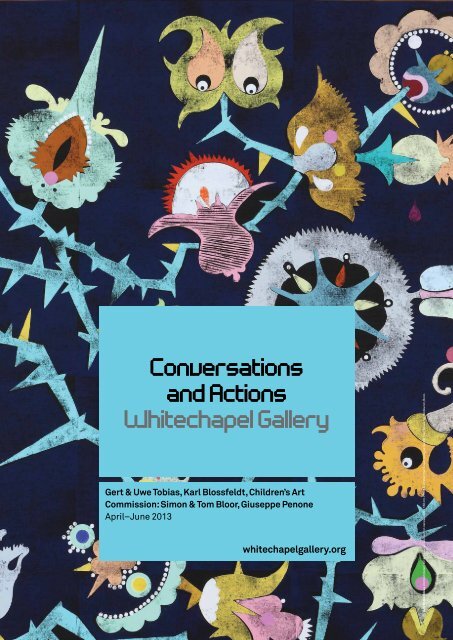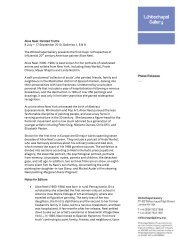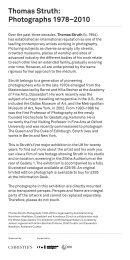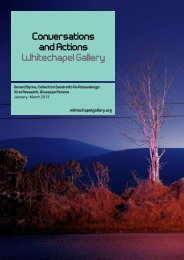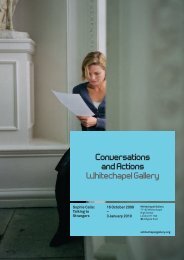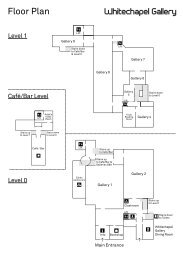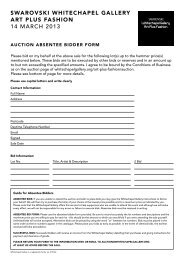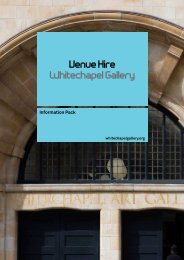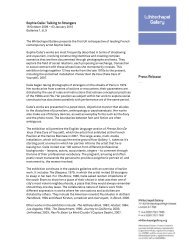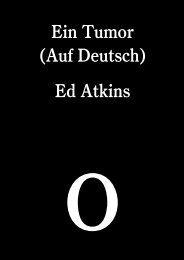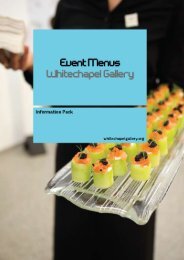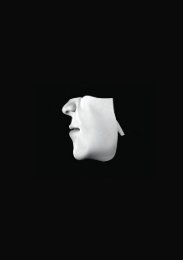Download - Whitechapel Gallery
Download - Whitechapel Gallery
Download - Whitechapel Gallery
Create successful ePaper yourself
Turn your PDF publications into a flip-book with our unique Google optimized e-Paper software.
Conversations<br />
and Actions<br />
<strong>Whitechapel</strong> <strong>Gallery</strong><br />
Gert & Uwe Tobias, Karl Blossfeldt, Children’s Art<br />
Commission: Simon & Tom Bloor, Giuseppe Penone<br />
April–June 2013<br />
whitechapelgallery.org<br />
Gert & Uwe Tobias Untitled (detail) 2012, coloured woodcut on canvas, 200 x 168 cm. Photo © Alistair Overbruck, Cologne/Gert & Uwe Tobias/VG. Bildkunst, Bonn.
Introduction: Conversations & Actions<br />
Conversations & Actions has been put together by the <strong>Whitechapel</strong> <strong>Gallery</strong>’s Education<br />
Department to introduce primary and secondary school teachers and group leaders in<br />
general to each season of exhibitions and new commissions at the <strong>Gallery</strong>. It explores key<br />
themes within the exhibitions on display by suggesting questions to spark conversation,<br />
warm-up activities and discussions around works in focus, proposing actions that can be<br />
realised in the <strong>Gallery</strong> or in the classroom.<br />
Illustrations and artists’ quotes are included throughout as well as links to further<br />
information about the artists and works. In addition to this resource, we recommend<br />
referencing the ‘further information’ sections throughout and identifying any crosscurricular<br />
connections with other subject areas before your visit. We also recommend<br />
calling the Education Department in advance to discuss your visit, the use of our studio<br />
spaces (which can be booked free of charge) as well as other events at the <strong>Gallery</strong> listed at<br />
the end of this resource.<br />
We hope you enjoy your visit.<br />
<strong>Whitechapel</strong> <strong>Gallery</strong> Map<br />
Level 1<br />
Lift<br />
Lift<br />
Stairs down<br />
to Café/Bar<br />
& Stairs Level down 0<br />
to Café/Bar<br />
& Level 0<br />
Lift<br />
Lift<br />
Lift<br />
Lift<br />
Artist’s<br />
Video<br />
Room Artist’s<br />
Video<br />
Room<br />
Lift<br />
Stairs up<br />
to Level 1<br />
Stairs up<br />
to Level 1<br />
Café/Bar Level<br />
Stairs down<br />
to Level 0<br />
Stairs down Stairs down<br />
to Level 0<br />
to Café/Bar<br />
& Level 0<br />
Lift<br />
Lift<br />
Stairs down<br />
to Level 0<br />
Stairs down<br />
to Level 0<br />
Lift<br />
Lift<br />
Artist’s<br />
Video<br />
Room<br />
Stairs up<br />
to Level 1<br />
Level 0<br />
Stairs down<br />
to Level 0<br />
Lift<br />
Lift<br />
Lift<br />
Stairs up<br />
to Café/Bar<br />
Stairs up<br />
to Café/Bar<br />
Stairs up<br />
to Café/Bar &<br />
Galleries Stairs up 8&9<br />
to Café/Bar &<br />
Galleries 8&9<br />
Stairs down<br />
to Level 0<br />
Level 0<br />
Lift<br />
Stairs up<br />
to Café/Bar<br />
Stairs up<br />
to Café/Bar &<br />
Galleries 8&9<br />
Lift<br />
Lift<br />
Stairs up<br />
to Level 1<br />
Stairs up<br />
to Level 1<br />
Stairs down<br />
to Toilets<br />
Stairs down<br />
to Toilets<br />
Stairs up<br />
to Level 1<br />
<strong>Whitechapel</strong><br />
<strong>Gallery</strong><br />
Dining Room<br />
Lift<br />
Stairs down<br />
to Toilets
Spring 2013 at the <strong>Whitechapel</strong> <strong>Gallery</strong><br />
Spring 2013 sees the arrival of a wide variety of exciting new exhibitions and<br />
commissions at the <strong>Whitechapel</strong> <strong>Gallery</strong>. In <strong>Gallery</strong> 1, Gert & Uwe Tobias present<br />
collaborative woodcuts, sculptures, collages and drawings; and Galleries 8 and 9 house<br />
a major presentation of self taught photographer Karl Blossfeldt’s botanical images.<br />
Giuseppe Penone: Spazio di Luce (Space of Light) continues in <strong>Gallery</strong> 2.<br />
Black Eyes and Lemonade: Curating Popular Art in <strong>Gallery</strong> 4 revisits an exhibition<br />
of British Popular Art held at the <strong>Whitechapel</strong> <strong>Gallery</strong> in 1951 including original<br />
exhibits and archival material. The third in a year-long series of displays of works<br />
from Collection Sandretto Re Rebaudengo: A Love Meal focuses on sculpture in the<br />
collection, looking at different approaches to portraiture and the construction of<br />
social and cultural identity.<br />
Finally, the Children’s Art Commission, Simon & Tom Bloor: Loose Parts takes place<br />
in Galleries 5 and 6. The artists present a new body of work resulting from a year-long<br />
residency at Hermitage Primary School in Tower Hamlets.<br />
Gert & Uwe Tobias<br />
16 April–14 June 2013<br />
Karl Blossfeldt<br />
16 April–14 June 2013<br />
Childrens Art Commission:<br />
Simon & Tom Bloor: Loose Parts<br />
19 March–9 June 2013<br />
Collection Sandretto Re Rebaudengo:<br />
A Love Meal<br />
19 March 2013–9 June 2013<br />
The Bloomberg Comission:<br />
Giuseppe Penone<br />
4 September 2012–September 2013
Gert and Uwe Tobias<br />
<strong>Gallery</strong> 1<br />
Born in Romania in 1973, twin brothers Gert and Uwe Tobias live and work in Cologne,<br />
Germany. Collaboratively they make woodcuts, collages, sculptures and typewriter drawings.<br />
The works of art in this exhibition bring together these diverse media.<br />
Visually they combine the lines, shapes and block colours of geometric Abstraction with<br />
narratives reminiscent of Surrealism and patterns drawn from ornamentation and folk art.<br />
The woodcuts and wall-designs display a strong interest in the graphics of the early<br />
20th century alongside an exploration of folkloric ornamentation and floral patterns as<br />
precursors of abstraction. Such Modernist references are juxtaposed with fragmented<br />
shapes and characters, spilling from woodcut and canvas into ceramics and the exhibition<br />
space, allowing viewers to immerse themselves in subversive, carnivalesque narratives.<br />
Employing different media and artistic traditions, Gert and Uwe Tobias dissolve<br />
boundaries between craft and fine art, abstract concept and unconscious fantasy,<br />
and modernity and tradition.<br />
Their diverse use of media is tied together with a site-specific wall-design so that:<br />
“When viewers come into the <strong>Gallery</strong>, they should feel as if they are plunging into the world<br />
of the Tobias brothers. Through the choice of works, their placement and the painting of<br />
the walls, we try to facilitate this ‘plunging in’ while at the same time also offering fresh<br />
perspectives on the individual works.”<br />
Gert and Uwe Tobias, interview with Eisler Curator, Daniel F. Herrmann, 2013
The Tobias brothers use a variety of media to develop their work, engaging in an<br />
on going dialogue taking it in turns to add, move, or replace material.<br />
They bring together disparate themes to disrupt and clash conventional associations<br />
between ideas and images, a process and methodology that can be identified<br />
throughout the works exhibited. For example in their ceramic work you find pieces of<br />
mass produced ceramics combined with unusual and vulgar forms.<br />
Talk about how Gert and Uwe Tobias work together, both in initiating ideas and<br />
then making work. Take time to look at the work on display while thinking about the<br />
processes that the brothers use.<br />
What might these works tell you about Gert and Uwe’s collaborative process?<br />
How do the additional forms on the ceramics change or disrupt your perception<br />
of the original object?
Action – beyond the <strong>Gallery</strong><br />
Work together in pairs to create a collage, taking it in turns to add, move and remove<br />
elements until you are both satisfied with the image.<br />
Think about where you will find the material for your collage using a mixture of<br />
recognisable and abstract forms.<br />
Try working on a collage in larger groups in the classroom, moving round to each<br />
table systematically to work on the next collage. Bring the final pieces together<br />
and as a class discuss how they are composed. How did you find the process of<br />
working in this way?<br />
Folkloric iconography from European cultures can be found throughout the Tobias’s<br />
work – you will notice decoration, repetition and ornamentation of various forms.<br />
Both real and imagined animals regularly appear, most commonly flying creatures often<br />
montaged to create new fantastical hybrids. You will also notice that eyes frequently<br />
appear. The resulting images are often quite disturbing, juxtaposing and interrupting<br />
the formalised backgrounds.
What repeating images can you find throughout the works?<br />
How does the repetition of images affect your experience of the exhibition?<br />
What do the animals and plants symbolise? Where do you think they come from?<br />
Action – beyond the gallery<br />
Investigate different folk and fairy tales from European culture, for example the<br />
Brothers Grimm or Hans Christian Andersen.<br />
Experiment with different paper cutting techniques to create your own creature or<br />
plant life.<br />
Gert and Uwe Tobias’ woodcuts and wall-designs display a strong interest in the<br />
graphics of the early 20th century, including the experimental typography of Jan<br />
Tschichold and the exhibition designs of El Lissitzky. Their woodcuts are handmade and<br />
each is unique.<br />
Grids are used as a graphic tool or as an organising system. Geometric forms are<br />
layered and lines are used to frame and divide. The Tobias’s have created a site-specific<br />
wall design which ties the different elements of the exhibition together.<br />
At the back of the exhibition you will see a triptych of images where the serrated<br />
edges of the wall design apply an aggressive edge that juxtaposes with the<br />
content of the works.
How do you feel when you look at abstract work? What can you see?<br />
Do you think these shapes and forms have a basis in real-life objects?<br />
What could they be?<br />
Look at Karl Blossfeldt’s photographs in Galleries 8 and 9. Can you make a comparison<br />
between these abstract images and the work of Gert and Uwe Tobias?<br />
Think about other things around you that are abstract, such as fabric patterns,<br />
scrap and waste material or food packaging. Make your own abstract collage<br />
from found materials.<br />
Use squared paper to make an image using simple geometric shapes.
Karl Blossfeldt<br />
Galleries 8 and 9<br />
Karl Blossfeldt (1865–1932) is recognised as one of the key figures in the<br />
development of 20th century photography.<br />
As a self-taught photographer, Blossfeldt used this newly emerging medium to<br />
support his argument that all forms created by man. Building a series of cameras<br />
with interchangeable lenses, he was able to examine his botanical specimens in<br />
unprecedented, microscopic detail revealing their tactile nature, intricate forms<br />
and uncanny characteristics.<br />
Blossfeldt produced the majority of his photographs during his tutorship in<br />
Berlin where he worked in relative obscurity until he was invited to exhibit at<br />
Karl Nierendorf’s gallery in 1926. With the encouragement of this gallerist,<br />
Blossfeldt brought together a number of his images of plants in one volume,<br />
a selection of which are shown here. The response to the first edition by such<br />
figures as critic Walter Benjamin repositioned Blossfeldt at the heart of debates<br />
around modern art and photography.<br />
This exhibition looks at the circulation and use of these images through such<br />
activities as book production, teaching and exhibition making. It also considers<br />
the reaction to the publication in 1928 of Blossfeldt’s Urformen der Kunst<br />
(Artforms in Nature). Shown alongside his book works are five, rarely-seen ‘working<br />
collages’, which are believed to have assisted Blossfeldt in the editing and organisation<br />
of material for his publications. While they follow a format that we are now familiar with<br />
through conceptual art practice’s analysis through a grid structure, they demonstrate<br />
how Blossfeldt at an early stage, categorised his subject matter and drew comparisons<br />
between diverse natural forms.
Take some time to consider the collages on display. Blossfeldt used collage<br />
and created photographic studies as a way to process, assess and compare the<br />
photographs he produced.<br />
Think about the effect of presenting photographs in a grid.<br />
How does this alter perception of the image when viewed as a whole?<br />
Use old magazines and cut out images to create collages of images formatted in a<br />
grid, keeping in mind categories, colour, size and layout.<br />
Repeat the exercise, this time with the whole class responding to the same theme or<br />
category. Discuss the process for selection and compare the resulting collages.<br />
<strong>Gallery</strong> 8<br />
Karl Blossfeldt trained as a sculptor and taught at what is now Berlin University of<br />
the Arts from the late 19th century until his death in 1932. Throughout his career,<br />
Blossfeldt amassed a vast body of botanical photographs that are now acknowledged<br />
for the critical role that they played in new approaches to observation and scale,<br />
heralding the transition from Art Nouveau’s preoccupation with form to Modernism’s<br />
analytical methods. <strong>Gallery</strong> 8 shows over 80 images that were used by Blossfeldt in his<br />
teaching practice. These photographs acted as a tool to assist students in his plant<br />
modelling class and simultaneously formed part of the research and development of<br />
Blossfeldt’s argument for the primacy of natural form over man-made constructions.<br />
The subsequent publication of a selection of these images in 1928 caught the attention<br />
of artists including Bauhaus tutor László Moholy-Nagy, who applied Blossfledt’s close<br />
scrutiny of flora to the emerging tendency of New Objectivity photography, which<br />
opposed expressionistic form in favour of a direct approach to recording subject<br />
matter. The final selection of works in this <strong>Gallery</strong> focuses on Blossfeldt’s exhibitionmaking<br />
with a series of seldom shown, larger-scale prints that are understood to have<br />
been produced for Blossfeldt’s first display at Karl Nierendorf’s gallery in 1926. These<br />
are shown with a number of journals and magazines such as Atlantis, Documents and<br />
UHU that demonstrate the way in which Blossfeldt’s practice was recontextualised<br />
within the discourses of Surrealism in the period immediately after his death in 1932.
Blossfeldt dissected plants beyond recognition and used photography to magnify,<br />
progressively simplify and break down the natural unity of plants, resulting in<br />
abstracted images.<br />
It was Blossfeldt’s belief that ‘all man-made forms had their origins in nature’.<br />
Looking at the photographs in <strong>Gallery</strong> 8, can you find images that support this theory?<br />
Collect images of buildings from books, magazines or the internet. Can you find<br />
images from nature that have a similar form? Display ‘matching’ images in pairs next<br />
to each other.<br />
Blossfeldt’s direct approach to<br />
observation and close scrutiny of<br />
plants led to him become a pioneer<br />
of the New Objectivity movement<br />
which arose in Germany in the 1920s<br />
as a response to Expressionism.<br />
Research other photographers<br />
associated with the New Objectivity<br />
movement, for example Bernd and<br />
Hilla Becher (who were greatly<br />
influenced by Blossfeldt) and Albert<br />
Renger-Parzsch. What are the key traits<br />
and commonalities between the works<br />
of these artists?<br />
Think about the process Blossfeldt uses in his meticulous studies of plants.<br />
Choose an everyday object and take a series of stills as a tool for investigation,<br />
experimenting with magnification and scale.<br />
Repeat the exercise, this time outdoors, choosing larger objects to photograph (for<br />
example buildings, trees, vehicles).
Children’s Art Commission, Simon & Tom Bloor: Loose Parts<br />
Galleries 5 and 6<br />
Every year the <strong>Gallery</strong> commissions an artist to create a work of art that engages<br />
children. Birmingham and London based artists Simon and Tom Bloor present an<br />
interactive installation that transforms the <strong>Gallery</strong> walls into a giant blackboard for<br />
visitors to draw on.<br />
Loose Parts considers the utopian potential of creativity and play. Developed from<br />
workshops during a year-long residency at Hermitage Primary School, Tower Hamlets,<br />
small clay sculptures were crushed and shaped by children, instigating a sense of<br />
playful rebellion within the school.<br />
This act of ‘encouraged vandalism’ led to the making of chalk sculptures that can<br />
now be used by visitors to draw, write or doodle on the <strong>Gallery</strong> walls. Alongside these<br />
sculptures, a series of print works recall the process of creation through destruction.<br />
The exhibition title refers to artist and architect Simon Nicholson’s ‘Theory of<br />
Loose Parts’, first published in 1971, which proposes that ‘loose parts’ in our<br />
environment empower creativity in children and adults alike. Simon and Tom Bloor<br />
(b. 1973) work across a variety of materials and formats from drawing, installation<br />
and sculpture to public art. Much of their work is inspired by the urban landscape as<br />
well as 20 th Century art and design.
Display cases in the <strong>Gallery</strong> show the small clay sculptures made by Simon and Tom<br />
Blooor, crushed and destroyed by the children. Images of the destruction in process<br />
can be seen around the <strong>Gallery</strong>. Imagine how the children would have felt when they<br />
were asked to do this and as a group make a list of words to describe these feelings.<br />
The clay forms were cast and made into chalk sculptures that can be used by visitors<br />
to draw on the walls. Pick one up and try to fit your hand around the imprint.<br />
Use the chalk to draw or write on the walls – do you draw in the same way that you<br />
would on paper? Are you normally allowed to draw on walls?<br />
The ‘Theory of Loose Parts’, devised by artist and architect Simon Nicholson, argues<br />
that children love to experiment with variables, or ‘loose parts’, in our environment.<br />
Some examples of loose parts are: sounds, smells, shapes, materials, animals, words,<br />
ideas and music.<br />
Nicholson defined the theory of loose parts as the following:<br />
‘In any environment, both the degree of inventiveness and creativity, and the possibility<br />
of discovery are directly proportional to the number and kind of variables in it.’<br />
Think about the structure you have previously set for creative activity in the classroom.<br />
How could you encourage the potential for exploration and outcomes to evolve<br />
naturally by increasing and varying the supply of ‘loose parts’ for example by<br />
providing pupils with a broader set of materials to use, or by giving them an<br />
open-ended brief to respond to?
The Bloomberg Commission: Giuseppe Penone:<br />
Spazio di Luce (Space of Light)<br />
<strong>Gallery</strong> 2<br />
Repeating the Forest<br />
A shelter, a ceiling of trees, a floor of trees, a wall of trees.<br />
If you look at a ceiling, a floor, a wall of wood, you see the<br />
trunks, branches, leaves. It is helpful if you can understand<br />
from the design of the wood the shape of the trunk, of the<br />
branches, of every single tree. The glance that runs along the<br />
wood’s structure, passes across the shape of the tree as<br />
insects have done.<br />
Giuseppe Penone, Spazio di Luce, 1969<br />
The latest Bloomberg Commission for <strong>Gallery</strong> 2 is of the work of Italian artist<br />
Giuseppe Penone (b. 1947, Garessio, Italy), who over the past 45 years has examined<br />
society’s understanding of nature, insisting that the spheres of culture and nature are<br />
inextricably linked. In the late 1960s, he became associated with the innovative Italian<br />
group Arte Povera, who inspired by the radical politics of the time and frustrated by<br />
the limitations of academic art education, embraced diverse sculptural practices and<br />
materials for their work to have a wider social impact. Trees and nature have been a<br />
consistent theme and life-long preoccupation in Penone’s work. In his early career, he<br />
performed many ‘actions’ or performances (which survive only as photographs) that<br />
took place in forests near Turin and his home town of Garessio.<br />
Walk around Penone’s sculpture of a tree, looking inside, through and all around<br />
the space of the <strong>Gallery</strong>. If you are drawn to touching the sculpture, go ahead.<br />
The sculpture was made specifically for this former library space.<br />
How does the bronze cast of a tree relate to the history of the space?<br />
Does encountering the sculpture remind you of an experience you have had outdoors?<br />
How does the atmosphere in the <strong>Gallery</strong> compare to that of the street outside?<br />
Work in Focus: Space of Light, 2012<br />
Why is this work called Space of Light?<br />
Why do you think the artist allows you to touch it when usually you can’t touch<br />
sculpture in a <strong>Gallery</strong>?<br />
What is it made from and how was it made?<br />
What does a tree symbolize to you?
This bronze cast of a larch tree felled in a valley in Turin was made through an ancient<br />
process called ‘lost wax’ casting, where the interior and exterior of the tree are<br />
deliberately reversed. It was cut into stand alone sections in Penone’s studio, covered<br />
in a layer of silicone, then wax and finally plaster. Liquid bronze was poured into the<br />
area where the wax was, melting it and creating a layer of bronze with the interior then<br />
being painted with gold leaf. It is important for Penone that the material is bronze<br />
- a natural, vegetable product that was heated by burning wood, linking to the<br />
lifecycle of the tree.<br />
When we look up vertically at trees, we see how they move towards the light and how<br />
they grow, but in Penone’s piece the light is within. The artist is interested in how<br />
we relate to the natural world through touch - for example, the fingerprints on the<br />
outside protect the memory of the many hand’s involved in the sculpture’s making.<br />
He feels it is important to understand through touch rather than sight – one of the<br />
primary reasons he moved from painting to sculpture as an artist. Although Spazio di<br />
Luce is a monument to nature, it is not the artist’s intention for it to be a statement on<br />
contemporary environmental issues. Penone is interested in human interaction with<br />
and perception of the environment, and our relationship to the ecosystems we inhabit,<br />
believing the immediate encounter to be of utmost importance.<br />
Action: In the <strong>Gallery</strong> and beyond<br />
Materials: paper, charcoal, graphite, pencil<br />
- Using Penone’s drawings in the Annex space as inspiration, create your own rubbing.<br />
- Look around the space you are in (whether it’s the <strong>Gallery</strong> or your school) at a piece<br />
of wood in the floor/ ceiling or as part of a piece of furniture.<br />
- Using rubbing techniques, discover the different edges and textures with charcoal or<br />
graphite on paper.<br />
- Find out what it is made from and what the tree it is made from may have looked<br />
like as a young sapling.<br />
- Draw the block of wood with the sapling in it in a similar way to Penone.<br />
Action: In the <strong>Gallery</strong> and beyond<br />
Materials: pens/ pencils and paper<br />
Throughout his career, Penone reflected on his work by writing poetic sayings. Some<br />
of these are listed in the Annex space, such as Repeating the Forest listed above.<br />
Create your own poem in response to Spazio di Luce and the space it is in:<br />
- Think about what the former library that is now home to Penone’s work would have<br />
looked like, and write down some descriptions – e.g. walls lined with books,<br />
people reading etc.<br />
- Think about what the space is used for now by observing other people in the<br />
<strong>Gallery</strong> space.<br />
- In the same way that in Repeating the Forest, Penone talks about the trees that the<br />
walls, ceiling and floor used to be made from; write some descriptive text or a poem<br />
about how the <strong>Gallery</strong> used to be a library and what it’s used for now.
Further information<br />
Material from Penone’s archive is included in a series of displays around the themes of<br />
Imprint, Positive/ Negative, Touch and Light in the adjacent space including writings,<br />
sketches and photographs.<br />
A short film including an interview with Penone can be found here and outside the<br />
exhibition: whitechapelgallery.org/exhibitions/the-bloomberg-commission-giuseppepenone-spazio-di-luce<br />
Find Out More<br />
Self-directed <strong>Gallery</strong> Visits<br />
Tuesdays, Wednesdays and Thursdays during term time.<br />
Clore Creative Studio and throughout the <strong>Gallery</strong>.<br />
Book a free self-directed visit including use of the Clore Creative Studio. Free school<br />
and family resources for current shows now available online.<br />
Teachers’ CPD: Inset Days & Twilight Sessions<br />
Primary: 4 July – The Spirit of Utopia with Daniel Wallis (4 – 6pm).<br />
Secondary: 9 July – The Spirit of Utopia with Daniel Wallis (4 – 6pm)<br />
Discover new ways of introducing your students to the <strong>Gallery</strong>’s exhibitions and<br />
resources in these inspiring new artist-led CPD sessions for primary and secondary<br />
school teachers.<br />
In association with Tower Hamlets Arts and Music Service.<br />
Clore Creative Studio & Galleries (Free. Refreshments included. Booking required).<br />
All Schools & Teachers’ activity free of charge.<br />
Booking required. To find out more and book schools or teachers events contact:<br />
education@whitechapelgallery.org<br />
T +44 (0)20 7522 7894


